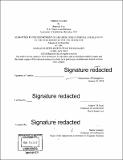| dc.contributor.advisor | Andrew M. Scott. | en_US |
| dc.contributor.author | Cho, Bumsuk | en_US |
| dc.contributor.other | Massachusetts Institute of Technology. Department of Architecture. | en_US |
| dc.date.accessioned | 2018-05-23T16:33:00Z | |
| dc.date.available | 2018-05-23T16:33:00Z | |
| dc.date.copyright | 2018 | en_US |
| dc.date.issued | 2018 | en_US |
| dc.identifier.uri | http://hdl.handle.net/1721.1/115747 | |
| dc.description | Thesis: M. Arch., Massachusetts Institute of Technology, Department of Architecture, 2018. | en_US |
| dc.description | Cataloged from PDF version of thesis. | en_US |
| dc.description | Includes bibliographical references (page 89). | en_US |
| dc.description.abstract | This thesis examines role of the mega-scale urban figure, specifically its appropriateness within contemporary cities. Since Rem Koolhaas's 1993 essay, "Bigness or the Problem of Large," the concept of mega-scale urban intervention has been a prominent issue both in architectural theory and practice. The newly created urban figures, physically dominant in the city, not only became catalytic but also became immortalized within an urban fabric. And while such urban figures remain intact, our contemporary cities are experiencing unprecedented speeds of change and complexity. This trend raises a question: "Is the mega-form still a relevant urban figures to respond to the needs of the cities.- If not , what are the causes and effects of urban figures, and how can the concept be revised to be more responsive to the aspiration of contemporary cities? This thesis investigates, a mega-form in Seoul, South Korea constructed in 1968. The mega urban form occupies the Jongno area of Seoul; as a significant and dominant urban figure registers at the larger scale of the city and yet divides the multiple industrial. It is likely that in the near future that this area will be subject to major redevelopment together with many of the surrounding smaller working communities. The main body of this thesis, then, will be a design study into the appropriate urban figure that can operate as infrastructure that provides enhanced connectivity, generates new ideas about urban space and the public realm, and performs as an ecological system that fuels sustainable community revitalization. In rethinking the existing mega project, this thesis will consider how to integrate the layers of the past into a new relationship with reality of contemporary Seoul through the medium of the architecture and urban transformation. | en_US |
| dc.description.statementofresponsibility | by Bumsuk Cho. | en_US |
| dc.format.extent | 89 pages | en_US |
| dc.language.iso | eng | en_US |
| dc.publisher | Massachusetts Institute of Technology | en_US |
| dc.rights | MIT theses are protected by copyright. They may be viewed, downloaded, or printed from this source but further reproduction or distribution in any format is prohibited without written permission. | en_US |
| dc.rights.uri | http://dspace.mit.edu/handle/1721.1/7582 | en_US |
| dc.subject | Architecture. | en_US |
| dc.title | Urban figure | en_US |
| dc.type | Thesis | en_US |
| dc.description.degree | M. Arch. | en_US |
| dc.contributor.department | Massachusetts Institute of Technology. Department of Architecture | |
| dc.identifier.oclc | 1036986830 | en_US |
